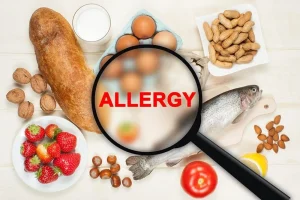Food allergies tend to be rather complicated and even frightening to the individuals suffering as well as their family members. The smile one wears while eating a meal turns ugly when one finds out something wrong with that pleasant situation. The extent of sensitivity of an individual’s body can be as low as a headache or as high as life-altering experiences. That is why looking for the indicators is quite significant for any person who wishes to sail through these intricate variations of foods.
This article today will look into the behavioural characteristics that constitute food allergies in individuals of varying age groups. Among other things, we will be looking at the most common of these allergens, how they are misdiagnosed, and how they are treated. You ask why you should know about food allergies; the answer is that with knowledge comes power. We will let you know what you require for food allergies so that you make the right decisions and maintain your health.
Explain Food Allergies:
Food allergies are a type of hypersensitivity that occurs when the immune system responds to certain food proteins as if they were pathogens. This defensive action can cause a variety of reactions, sometimes instantaneously after food has been eaten. On the other hand, the symptoms may include stomach complications that occur due to the consumption of certain food items, which are referred to as food allergies and this could have severe health consequences. On the other hand, they can cause anaphylaxis, which is a form of allergic reaction that can be life-threatening and requires medical intervention immediately.
Over the recent years, the occurrence of food allergies has been increasing slowly. Different studies have been studying some of these factors, including hereditary and environmental influences known to be a significant side of this increase. It is important to appreciate how various substances affect the body in the management of these allergies. Careful dietary monitoring and awareness of first symptoms may prevent unwanted events and promote overall health.
Most Common Food Allergens:
Food allergies can be of various origins, but there are some allergens, which are especially more widespread than the remaining ones.
Milk is one of the first food allergens, especially in children. This allergy is prone to onset at a young age and in some people, there may be a persistence to the adult age.
Eggs are also one of the food groups that many allergic people tend to avoid. Very young children tend to be the most affected, especially. Most children outgrow this intolerance as they grow up.
Peanuts are another class of food that is highly allergenic and can cause life-threatening traumas. A little portion of this food is enough to provoke anaphylaxis, and thus every sensitive individual should refrain from eating anything related to peanuts.
Tree nuts include nuts such as almonds and walnuts, and other nuts in this category may have the same sensitivity as the first class. Tree nut allergies are unique as opposed to other allergies where most people develop tolerance in that they are a lifetime pathological condition.
Wheat is another very common food allergy present in several common diets. Wheat or any other products containing wheat become dangerous for people with coeliac disease or wheat intolerance.
Soy is present in a lot of processed food and is widely used in infants that use soy-based formulas.
Symptoms of Food Allergies in Children:
Food allergies in children present in different forms and therefore need parents to be on their toes. The reaction may occur shortly after an individual has ingested an allergen with an average time frame of several minutes or a few hours.
Typical signs are skin diseases toxic states like hives and skin eczema. These diseases can make small children uncomfortable or distressed.
Other gastrointestinal problems that are common to children within this category include vomiting, diarrhoea, and abdominal aches. In these cases too, as children start eating many more things than just milk, they may find these acute problems previously noticed centred on only food worsening.
Respiratory problems should be on the list also. Symptoms that include wheezing, coughing, or trouble breathing indicate a more severe allergic reaction called anaphylaxis.
These two symptoms have been confined within the gastrointestinal borders and do not ensure that other forms of symptoms are not present. Usually, these symptoms are observed in children during the allergy episode; a change of behaviour is noticed; for instance, children may be more anxious or irritable easily. It is imperative to address the above issues in terms of early recognition so that if it turns out to be needed, treatment can be undertaken in time.
Symptoms of Food Allergies in Adults
In adults, the clinical picture of food allergies is more diverse than in children. This delay usually lasts only around 30 minutes but may take place several hours after eating. Symptoms most often occur immediately following reintroduction of the offending food, varying from rapid onset gastroenteritis, including syncope and anaphylaxis, or protracted, varying degrees of gastrointestinal discomfort lasting several days.
Common allergic reactions include hives and severe rashes that may be itchy. There is also swelling of the lips, tongue, and throat, which can be quite alarming. This can cause a struggle in swallowing or breathing.
Difficulty such as these is further encountered by quite a few. Adults may complain of cramps, vomiting, or diarrhoea after consumption of foods known to be allergic. Confusion might also arise with these symptoms since they are also found in other digestive dietary disorders.
Anaphylaxis is a set disease marketing a severe disability that requires appropriate intervention within a specific time frame. It involves shortness of breath and decreased blood pressure, which, if neglected, may result in death under certain successive conditions.
Hasty action upon recognising these signs helps make food allergies easier to handle in adults. Proper focus can help avoid dire issues later.
Wrong Diagnosis and Cross-Related Allegens
Food allergies are a condition that is most often mistaken for other allergies, which is the leading cause of misdiagnosis. Lots of complications occur since a lot of symptoms have been associated with a gastrointestinal disease or skin disease. This confusion makes proper treatment and management difficult.
Cross-reaction of allergens makes a whole new challenge. For example, people who are allergic to some form of pollen may also be allergic to certain fruits or vegetables because the proteins in them are similar. Patients must address their complete medical history to the medical professional.
In addition, testing sometimes comes back positive when it should not have, leading to more confusion in the diagnosis. In such situations, an allergist’s thorough assessment is important. The diversity of food reactions is something that needs to be acknowledged. Keeping a list of problems and related risks is helpful for healthcare professionals.
Food allergy management and treatment:
Management of food allergy is a process that has to be anticipatory. First, know what food triggers your allergy and avoid those foods. It is useful to write each meal that you eat for you to recognise the foods that seem to cause allergy the most. An allergist is paramount on this matter, as they may uncover some allergies that were not recognised. Some tests could be ‘allergy’ skin or blood tests where specific allergies may be explored and diagnosed. Upon determining what foods pose a risk, it is necessary to educate on allergies. Follow all instructions on how to use the emergency epinephrine epipen that has been prescribed to you and carry it with you. Friends, relatives, coworkers, and even young children should be informed about your allergy so that while out, especially in public places, they would be able to help you if need be.
A registered dietitian with expertise in food allergies would be appropriate here. They are helpful because they will make sure that allergy-risk-free meals are prepared. Not only education but also disease monitoring should be done; after eating new foods, one should monitor what reactions happened, if any. This vigilance improves or helps in refining your level of knowledge of how various substances interact with your body.
Strategies for Preventing Exposure to Food Allergens:
Your first line of defence is reading labels. Always check for allergens in pre-packaged foods, even if you’ve bought the same product before. If you are planning to have a meal outside, let the people in charge know about your allergies. Ask regarding the preparation of dishes and the kind of ingredients there are. Allergens can be tricky, and traces of them can easily be present in kitchens. It’s best to pass or bother looking for another dish or try speciality hotels that provide perfected allergy-free meals.
Meal prepping at home also helps control what goes into your food. Make sure you are careful not to cross-contaminate and have areas of your house that are free from allergens. Explain your allergies to friends and family. Their help can give an additional form of protection when eating in company or out. You should always have on your person anti-histaminic medication or an epinephrine auto-injecting pen when travelling. Preparedness is an assurance of comfort when you are in heating situations.
Conclusion:
The study exhibited that food allergies could greatly affect a person’s daily life due to the level of risk posed to an individual, which has been categorised into mild risks to serious reactions that may threaten one’s life and health. Both the individuals and their families must understand the issues regarding food allergens and the dangers that come with them. Here, awareness is of utmost importance. Because early comprehension of the symptoms will help the patients manage their conditions effectively.
In the case of patients with food allergies, the importance of designing an action plan that takes into account individual preferences cannot be overemphasised. This covers when to get medical attention as well as when to avoid accidental exposures. Support systems play a vital role as well. Finding and joining such groups may help mitigate the challenges and provide the motivation and help that is needed to ease the journey. Knowledge helps all of us cope with food allergy challenges and enjoy wonderful meals safely.
FAQs:
1. What are the eight principal food allergies?
The top eight food allergies include milk, eggs, peanuts, tree nuts, soy, wheat, fish, and shellfish.
2. What clues should I look for if I think my child has an allergy to some food?
Signs can be seen in the form of skin rashes or stomach problems within a short while after eating some types of food. The main point of action against allergies is to seek medical help as soon as possible.
3. Is it possible for adults to acquire certain food allergies?
Yes! Even if someone has eaten certain food items during their lifespan with no problems, it is still possible for them to develop new allergies. This occurrence is known as an adult-onset food allergy.
4. Can a person cross-react to the other allergens?
Sure! Some patients are allergic to certain proteins in food A and may be found to be allergic to proteins in food B that they have never eaten before.
5. What course of action is necessary if a serious reaction is expected?
If you have eaten some food that you suspect makes you sick and you experience some symptoms of anaphylaxis for the very first time—such as difficulty breathing or swelling—reach for medical help.




